
Indoor Block Play Activities: Share Your Ideas with Others
What can you do to help your children learn and grow while playing indoors?
We’d love to hear from you. If you’ve discovered a way of playing with Uncle Goose blocks that is distinctive, fun, and educational, why not share it?
Drop us a line or send us a photo or video of how you're playing with your blocks. Your stories may give others inspiration for indoor play and learning activities.
Until then, remember that children are naturally creative, imaginative, and resilient. When it comes to block play, you might want to take a step back and let them show you the way.
Watch what happens when you give children a set of blocks and let them play on their own. The ideas they come up with can be amazing!
Storytelling and Social Skills
Children spontaneously create stories and use blocks as props. They’ll build environments, characters, and plots. Storytelling is a valuable life skill. Let children use blocks to help them tell their stories. You can help by listening and accepting what they have to say.
As children build their fictional worlds, they use blocks to represent characters, props, and settings. One block may be an astronaut. Another may be a spaceship. Or a monkey. Watch with wonder at how your child’s imagine blossoms with ideas in only a few short moments of block play.
Building and Engineering Skills
When children put a group of blocks put together, they may become a structure on Mars. Or it may be a circus, a school, or an entire town. Children are doing more than telling stories: they’re practicing engineering skills.
They’re stacking blocks to form buildings and bridges. They’re discovering that structures with broad bases may be more stable than blocks stacked one on top of the other. And of course, they understand the joy of knocking down their buildings and rebuilding new and exciting worlds.
Intellectual and Social Growth
As children play together, you might hear them bandy about numbers and colors and animal names. “Find all the green letters. Here are the two blue numbers you wanted. No, that one has a horse on it. I need the one with a crocodile.”
If you hear statements like that, smile. It means children are assigning concrete meaning to the abstract concepts. They’re also learning colors, number, animals, letters, and more. It’s a sign of intellectual and social growth.
Developing Artistic Skills
It’s not uncommon for children to bring out other toys as they play with blocks. Artistic children bring out crayons and paper: they create rubbings of the embossed block sides. Or they’ll shine a flashlight on block structures and trace the shadows — then color them in.
Children might also press Play-Doh, Silly Putty, or modeling clay into the embossed sides of the block. Don’t worry: it comes out fine. And while children practice these artistic skills, you can be certain that they are also developing fine motor skills.
Learning Letters and Spelling
Blocks with letters on them help children learn to spell. They enjoy finding and stacking the letters of their names or names of animals and pets and people they love.
Even adults enjoy word games. It’s not unheard of for an adult to while away a few hours playing a makeshift game of Boggle with blocks. Some adults even enjoy creating word search puzzles with blocks.
Hone Social Interaction
After watching a child play with blocks for a while, an adult may want to jump in and join the fun. By playing with a child, you both hone social skills. You learn to share, take turns, tell stories, laugh, and learn together. These are the fundamental and necessary elements for a rich and rewarding life.
Get Even More Social
If you’ve discovered a unique way of playing with your blocks, share it with us and others. We’d love to hear from you: drop us a line or send us a photo or video of how you’re using your Uncle Goose blocks.
What are you accomplishing with your blocks? Your stories may give others inspiration for playing indoors.







